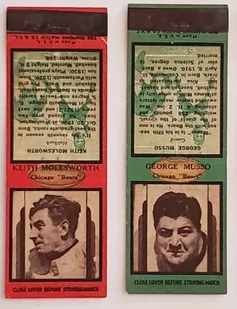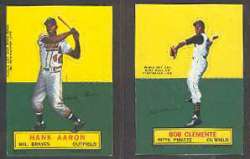1970 Kellogg's #12 Willie Mays (Giants)
| Grade |
NM/MINT |
| Book Value |
n/a |
| Our Price |
$ 49.95
Add to cart
|


Below are short bits & pieces on sportscard & baseball trading card collecting.
Please wander around the website for more info, prices, values & images
on vintage baseball, football, basketball, hockey, sport and non-sports cards.
1957 Topps Football Cards
Checklist & Values
In 1957 Topps created the modern day card by reducing the size of
cards to current standard 2-1/2 x 3-1/2 inches. Topps also increased
the set to 154 players and dramatically changed card format to a horizontal
split-card. Player selection was awesome with (31) future Hall-of-Famers.
1957's top rookies were Bart Starr, Johnny Unitas & Paul Hornung.
The only variation is card #58 Willard Sherman.
Click for complete
1957 Topps Football card values and prices
Note: You may be on that page right now.
|

1934,1935,1936,1937 Diamond
Football Matchbooks

Matchbook collecting was sweeping the nation back in the 1930's
with most sports matchbooks issued by Diamond Match Company out
of New York.
The football matchbooks were printed over a period of several
years in assortment of colors and included both professional and
collegiate football players.
1930's matchbooks are huge bargains for collectors as their
values are fractions of that of Goudey and other issues from the 1930's.
Diamond also produced several issues of Hockey and Baseball Matchbooks.
Click for complete
1935-1936 Diamond Baseball Matchbook Checklist and Prices
Click for complete
1934-1938 Diamond Football Matchbook Checklist and Prices
Note: You may be on that page right now.
|


1964 Topps Stand-Ups
Checklist & Values
One of Topps most popular 1960's test issues !!!
Blank-backed, unnumbered & standard size - cards were called
"Stand-Ups". "Stand-Ups" refers to a type of card that was die cut around
the player's picture. The background could be folded so the player's picture
could "stand up" alone.
1934-36 Batter Up and the 1951 Topps All-Star sets are 2 other popular
stand-up issues.
22 of the 77 cards are single prints making them twice as scarce and much
higher in demand.
Thanks to the green and yellow borders and that most cards have been folded,
1964 Stand-Ups extremely difficult to obtain in high grade.

 On the left and right are images of a pack and box.
Set packed with 19 Hall-of-Famers including the Top-5: Mickey Mantle,
Willie Mays, Roberto Clemente, Hank Aaron & Sandy Koufax.
On the left and right are images of a pack and box.
Set packed with 19 Hall-of-Famers including the Top-5: Mickey Mantle,
Willie Mays, Roberto Clemente, Hank Aaron & Sandy Koufax.
Click for complete
1964 Topps Stand-Ups checklist and prices
Note: You may be on that page right now.
|
1

Tobacco Cards
Starting approximately in 1886, sportscards, mostly baseball cards, were often
included with tobacco products, for promotional purposes and also because the
card reinforced the packaging and protected cigarettes from damage. These sports
cards are referred to as tobacco cards in the baseball card hobby. Over the next
few years many different companies produced baseball cards. Tobacco cards soon
started to disappear as the American Tobacco Company tried to develop a monopoly
by buying out other companies.
They were reintroduced in the 1900s, as American Tobacco came under pressure from
antitrust action and Turkish competition. The most famous and most expensive,
baseball card is the rare T206 Honus Wagner. The card exists in very limited
quantities compared to others of its type because Wagner forced the card to be
removed from printing. It is widely (and incorrectly) believed that Wagner did
so because he refused to promote tobacco, but the true explanation lies in a
dispute over compensation.
Soon other companies also began producing baseball and football cards. Sports magazines
such as The Sporting News were early entries to the market. Candy manufacturers
soon joined the fray and reflected a shift toward a younger target audience for cards.
Caramel companies were particularly active and baseball cards were one of the first
prizes to be included in Cracker Jacks. World War I soon suppressed baseball card
production.








 On the left and right are images of a pack and box.
Set packed with 19 Hall-of-Famers including the Top-5: Mickey Mantle,
Willie Mays, Roberto Clemente, Hank Aaron & Sandy Koufax.
On the left and right are images of a pack and box.
Set packed with 19 Hall-of-Famers including the Top-5: Mickey Mantle,
Willie Mays, Roberto Clemente, Hank Aaron & Sandy Koufax.
